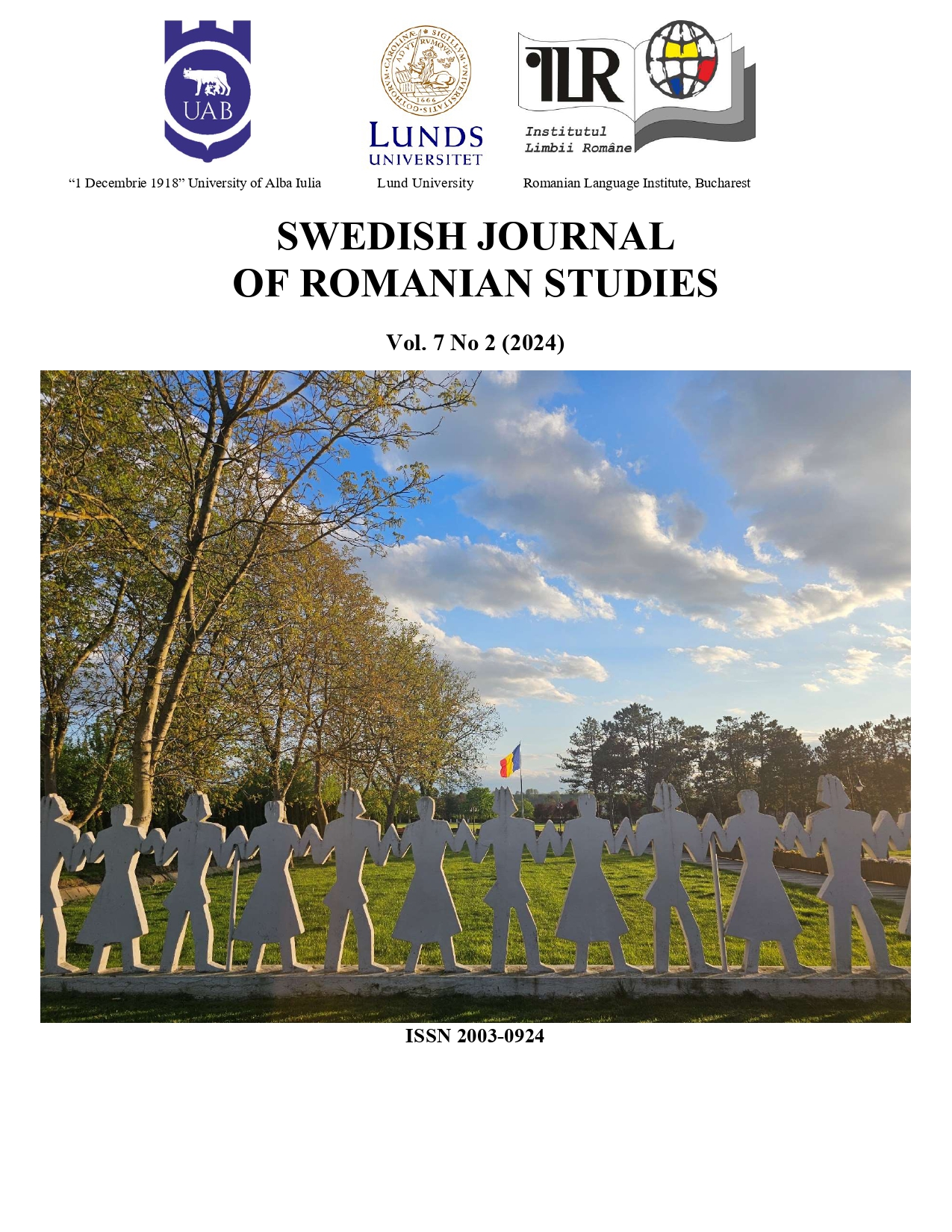Homeland in Romanian children’s literature written in the Diaspora
DOI:
https://doi.org/10.35824/sjrs.v7i2.25874Keywords:
childhood, ideology , idealised image , patriotic feelings , nationalismAbstract
Romanian children’s literature has always been situated at the crossways of cultural ideologies. The Romanian texts for children lack innocence due to the implicit level of cultural, social, and historical knowledge they mirror at different epochs. In this paper I investigate how literary texts for children written in Romanian communities living abroad present the idea of homeland. I examine literary works written by three contemporary Romanian writers living in Romanian communities in Serbia: Ana Niculina Ursuleanu, Radu Flora and Slavco Almăjan. My selection includes books published in between 1970 and 2010: Cu Soarele-n Creștet [With the sun on the head], (2006); Soare, Bună Dimineața! [Sun, good morning!], (1998); Cărările Nilului [The paths of the Nile], (2008); Piticii au Uitat să Crească [The dwarfs forgot to grow up], (1987); Pianul cu Păienjeni [The piano with spiders], (1991); Când Vine Primăvara [When spring comes], (1970). In my analysis, I focus upon the role of settings in building the image of an eternal Romanian homeland that transcends the national borders. Thus, I discuss three main types of settings that shape the fiction imagined by the proposed authors, related to the following environments: landscape, family, and school. My analysis considers the theory of landscape proposed by Mitchell (2002, p. 5) in Landscape and Power. According to it, landscape implies the interaction between the human, the natural, the self and the other. For each novel, I analyse the role of settings within the literary texts. I explore Radu Flora’s novel in connection with two elements of setting, landscape and school, respectively. In Ana Niculina Ursulescu’s books I look at the bond between family and landscape, while in Slavco Almăjan’s literary work I highlight the importance of landscape in building the image of childhood. These functions are classified according to a sophisticated range, from the purpose of clarifying the conflict or its function as a symbol (in When Spring Comes by Radu Flora), to the task of mood intensifier attributed to setting (in Balul Strugurilor [The party of grapes] by Slavco Almăjan).
My conclusions validate the idea that literary texts constantly build and convey an image of the Romanian identity and a sense of belonging to the Romanian homeland as marked by borders. I focus on nostalgia and irony as the main feelings the authors transmit about the image of homeland. On the one hand, the image of homeland in the literary works written by these three writers implies nostalgia, a feeling conveyed through an adult’s perspective of childhood. On the other hand, sometimes, as it happens in the case of the novel When Spring Comes, the narrator adopts a humorous perspective on history and human interactions among characters. As a final remark, I show that the selection of these three settings (landscape, family and school) creates the image of homeland in connection with a nationalist ideology. More precisely, children’s books reinforce the idea of unity between the two Romanian speaking communities (in Romania and Vojvodina) that share common cultural values. The representation of homeland reiterates a history-oriented ideology and legitimates the assimilation of nation to childhood.
References
Almăjan, S. (1987). Piticii au uitat să crească [The dwarfs forgot to grow up]. Pancicova: Libertatea.
Almăjan, S. (1991). Pianul cu păienjeni [The piano with spiders]. Pancicova: Libertatea.
Anderson, B. (2006). Imagined communities. London: Verso.
Carroll, J. S. (2012). Landscape in children’s literature. London: Routledge.
Flora, R. (1970). Când vine primăvara [When spring comes]. Pancicova: Libertatea.
Hollindale, P. (1988). Ideology and the children’s book. In P. Hunt (Ed.), Literature for children (pp. 23-37). London: Routledge.
Lukens, R. (1986). A critical handbook of children’s literature (6th ed.). New York: Longman.
Marcoin, F. (2015). L’enfance comme enjeu idéologique [Childhood as an ideological stake]. Idéologie(s) et roman pour la jeunesse au xxie siècle [Ideology(s) and youth literature in the 21st century] (pp. 23-36). Pessac: Presses Universitaires de Bordeaux. Retrieved March 4, 2024, from https://books.openedition.org/pub/8966
Mitchell, W. J. T. (2002). Landscape and power. Chicago: The University of Chicago Press.
Mozor, M. (2020). Imaginea școlii din Banatul sârbesc în perioada interbelică în romanul Când vine primăvara de Radu Flora [The image of school in Serbian Banat during the interwar period in the novel When spring comes by Radu Flora]. Romanoslavica, 2, 37-44. Retrieved June 30, 2023, from https://www.ceeol.com/search/article-detail?id=1106793
Nodelman, P. (1997). Fear of children’s literature: What’s left (or right) after theory? Reflections of Change. In S.L. Becket (Ed.). Children’s literature since 1945 (pp. 45-58). Westport, Connecticut: Greenwood Press.
Stephens, J. (1992). Language and ideology in children’s fiction. London, New York: Longman.
Ursulescu, A.N. (2006). Cu soarele-n creștet [With the sun on the head]. Pancicova: Libertatea.
Ursulescu, A.N. (1998). Soare, bună dimineața! [Sun, good morning!]. Novi Sad: S.L.R.
Ursulescu, A.N. (2008). Cărările Nilului [The paths of the Nile]. Reșița: Banatul Montan.
Downloads
Published
How to Cite
Issue
Section
License
Copyright (c) 2024 Cristina Sărăcuț

This work is licensed under a Creative Commons Attribution-NonCommercial 4.0 International License.
Authors who publish with this journal agree to the following terms:
a. Authors retain copyright and grant the journal right of first publication with the work simultaneously licensed under a Creative Commons Attribution-NonCommercial 4.0 International License that allows others to share the work with an acknowledgement of the work's authorship and initial publication in this journal.
b. Authors are able to enter into separate, additional contractual arrangements for the non-exclusive distribution of the journal's published version of the work (e.g., post it to an institutional repository or publish it in a book), with an acknowledgement of its initial publication in this journal.
c. Authors are permitted and encouraged to post their work online (e.g., in institutional repositories or on their website) prior to and during the submission process, as it can lead to productive exchanges, as well as earlier and greater citation of published work (See The Effect of Open Access).

